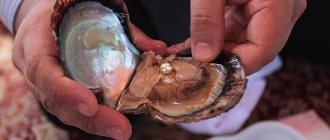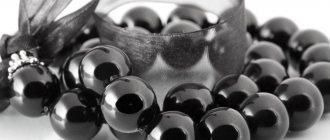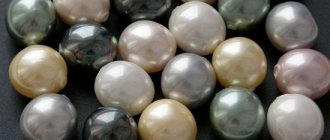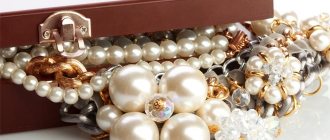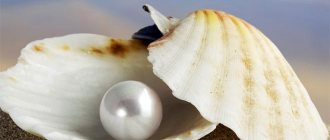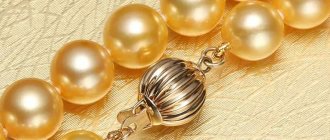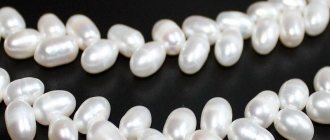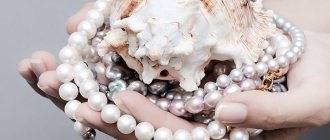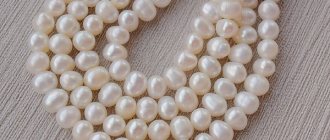Cultured pearls are a precious mineral formation artificially bred by man under conditions as close as possible to natural ones. To do this, mollusks are placed in their usual habitat, creating a semi-natural habitat. Every year, pearls grown by humans become more and more similar to those formed naturally. The technology is constantly being improved, which is due to the popularity of the mineral and its declining production due to the deteriorating environmental situation in the planet’s water bodies.
Story
People have known what pearls are since ancient times. It has long been found in the shells of marine and freshwater mollusks. This stone is the most ancient jewel on our planet.
It is believed that it was first discovered by accident while catching edible bivalves. Scientists believe that this happened in the waters of the Gulf of Mannar about 4,000 years ago .
The gem began to be used as jewelry and even as a monetary equivalent.
He was highly valued in the East - from China to North Africa, and was adored by the queens of ancient times - Semiramis, Cleopatra and others. The importance of pearls was so great at that time that Cleopatra considered earrings with two large pearls the most valuable of her jewelry.
This stone was highly valued in countries with access to the sea. They decorated statues of gods and heroes and were awarded for military exploits.
On the famous Monomakh's hat, pearls shimmer softly among other gems, and it is crowned with a cross with pearls.
Since the Middle Ages, these stones have been used to decorate crosses, icons, and robes of clergy, since among Christians pearls are a symbol of infallibility and purity.
The Russian word “pearl” comes from the Chinese name for this stone - “zhen zhu”. In Rus' it appeared through the Volga-Bulgar and ancient Turkic languages.
In most European languages, the name of this gem has the Latin root perl. It comes from a now unused word that denoted a specific type of mollusk.
In Russian, nacre is the outer coating of pearls.
Russian kingdom
It is known that huge quantities of sea pearls from the East flocked to Moscow. Even the British were involved in importing: for example, Ambassador Jerome Horsey gave a huge thread to Tsar Boris in 1586. Another foreigner, Jacques Margeret, recorded that he saw in the treasury at least fifty royal outfits embroidered with jewels at the edges, he saw dresses completely embroidered with pearls, as well as “dresses covered with pearl embroidery for a foot, half a foot, four fingers”! He was also amazed by half a dozen royal bedspreads, completely embroidered with pearls.
“Pearls were small, medium, large; Gurmyd grains, Kafim grains, shell grains, and non-diamond grains were distinguished; pearls were counted by grains, halves and spools.” Johann Kielburger
The amount of pearls in the treasury is easiest to imagine from the chronicles of the defeat: in 1611, having taken the Kremlin, the arrogant Poles, out of idleness, shot large pearls from muskets, and during the Salt Riot of 1648, rebel robbers measured pearls by the handful and sold them to those who wanted them by the capful.
Alexey Korzukhin. Hawthorn. 1882
Unknown artist. Parsun of Tsar Alexei Mikhalovich. 1670–80s
Unknown artist. Parsun of Queen Martha Apraksina. Late 17th century
Pearls were used to decorate hats, shoes, borders, sleeves... the list is endless. These costumes can be imagined from the 17th century parsun portraits depicting kings and queens. Paintings by anonymous masters are unlikely to faithfully depict their subjects. But the rich outfits were painted with extraordinary care - this is a legacy of the icon-painting tradition, where special attention was paid to the “pre-personal” (everything except faces and hands).
Of course, without recreating precious jewelry made from large round pearls, it is impossible to imagine historical painting of the second half of the 19th century on the theme of Rus'. Let us remember such painters as Konstantin Makovsky, Alexander Litovchenko, Grigory Sedov, Nikolai Nevrev, Sergei Solomko, etc.
Origin
Pearl is a stone of organic origin. Scientists do not consider it a mineral, but according to a long tradition it is classified as a precious stone.
Pearls are formed in the organisms of freshwater and marine mollusks. Sometimes grains of sand, shell fragments and other foreign objects get into sinks. If they come into contact with the mollusk's mantle (the soft shell that hides under the shell), the mollusk covers them with a layer of material that makes up its shell. This is how pearls are formed.
Sometimes several dozen pearls of various shapes are formed in the shell. But the greater their number, the smaller they are.
Only pearls that have a mother-of-pearl shell are valuable.
Pearls are found inside only some bivalves and gastropods, as well as the cephalopod nautilus. But zoologists believe that all types of mollusks can produce them.
Growing methods
Pearl culture was invented in China. People involved in the cultivation of mother-of-pearl minerals collected live river mollusks and placed clay balls in their mantle. The shells were immersed back into the water, and a few months later they were caught and full-fledged pearls were removed from the cavity.
Be sure to watch: Mallorca pearls - artificial or not: technology, price and properties
Today, water farms are common in China, Japan, Venezuela, and the Philippines. There are 2 technologies for obtaining stone: nuclear and non-nuclear.
Nuclear
The essence of the method is to use only sea mollusks. First, full-fledged adult aquatic inhabitants are looked for. Experts evaluate the mollusk's mantle, as well as the functioning of the gonad, the reproductive gland.
What the growing process looks like:
- The shell is opened with special equipment.
- A small incision is made in the mantle.
- The seed core and the ball are placed in the incision.
- Closed shells are placed in water.
Interesting! Over the course of a year, the thickness of the mother-of-pearl layer increases by 1 cm. Several years are enough to form a full-fledged stone.
Physicochemical characteristics
From the point of view of chemists, pearls are a composite of an inorganic substance (calcium carbonate) and an organic substance (conchiolin, a horny substance produced by the mollusk).
- The chemical formula is CaCO3 .
- Color - white, silver, yellowish, golden, blue, cream, green, pink, gray, black.
- The shine is pearlescent.
- Transparency ranges from translucent to opaque.
- Hardness - 3–4.
- Density - 2.6–2.78 g / cm3 .
The structure of the stone is layered.
Soluble even in weak acids.
Aristocratic excess
A slightly different story - portraits of the richest women of the Russian Empire. There are so many large pearls on them that it is no longer elegance, but arrogance. First of all, these are ladies from the Yusupov family - Zinaida Nikolaevna and her mother Tatyana Alexandrovna. They inherited this passion from the 17th-century princess Tatyana Vasilievna Yusupova, Potemkin’s niece. Her descendant Felix wrote about his great-great-grandmother in his memoirs:
“She was a passionate jewelery connoisseur and founded a collection that became famous. She bought the Polar Star diamond and many decorations from the French crown, jewelry of the Nepolitan queen and, finally, the unique and magnificent “Peregrina”, the famous pearl that belonged to Philip II of Spain and, they say, in ancient times - to Queen Cleopatra. The pearl was a pair of the one that the queen of Egypt dissolved in vinegar in order to surpass Anthony in table madness.”
Felix Yusupov. "Before Expulsion"
It is characteristic that in the portraits of Tatyana Vasilievna herself, created in the era of classicism and empire style, we will not find an excess of jewelry: the taste of the time did not allow such excesses in painting. But the representatives of the next generations lived in the second half of the 19th century - a more eclectic era, and therefore their portraits dazzle with the brilliance of jewelry.
Unknown author. Portrait of T.A. Yusupova. 1875
Franz Winterhalter. Portrait of T.A. Yusupova. 1858
Francois Flameng. Portrait of Zinaida Yusupova 1894
Tatiana and Zinaida Yusupov were written by Winterhalter, Makovsky, Serov and many others. For the history of art, the most valuable, of course, is the work of Valentin Serov - and for the history of jewelry, the work of Francois Flameng. Here Princess Zinaida is depicted with the giant pearl "Pelegrina", which her son sold in 1953.
Mining locations
Pearls are obtained from the shells of marine and freshwater mollusks, more often bivalves (mussels, etc.).
Sea “wild” pearls are found in:
- Persian Gulf;
- Gulf of Mannar;
- Red Sea.
For warm countries washed by the ocean or sea, the profession of pearl diver was traditional. But it is associated with a risk to life, which is why shellfish plantations are now being cultivated in many countries.
There are pearl plantations:
- off the coast of Japan and in some lakes of this country;
- in Burma (in the Bay of Bengal and the Andaman Sea). Burmese pearl is one of the best in the world.
Cultured pearls are no different from wild ones. The core of the future pearl is simply placed into the shell by specialists. After this, under their supervision, the invertebrate grows (and grows the pearl) for several years.
The largest jewel found in a mollusk shell is the “Pearl of Allah.” Its weight is 6.5 kg , and the weight of the mollusk is 300 kg . This jewel has an oblong shape and impressive dimensions - 24 x 16 cm .
Pearl is also found in clean, large rivers of Europe, Asia, and North America. Freshwater pearls are mined in:
- Russia;
- Germany;
- China;
- USA.
Interesting fact. One day, a South Korean resident bought pearl shells for a traditional Korean dish for 60 cents In one of the shells he discovered a rare black pearl with a diameter of 1.5 cm . It was valued at $60,000 .
How is it different from artificial pearls?
The imitation is created from cheap materials. It does not have the physical and magical properties of its precious counterpart. The first thing you need to pay attention to is the cost of the product. A low price is a sure sign of a cheap fake. There are also several other ways to check whether a stone is real:
- Surface. Artificial specimens are predominantly in the shape of a sphere, drop, hemisphere or rice. At the same time, there are completely no defects on the surface. Natural pearls are rarely this perfect.
- Hardness. Imitation pearls are even less durable than cultured pearls. It is very easy to scratch.
- Size. Beads of the same diameter are quite rare. Although laboratory-produced material has more similar dimensions, they still do not have to be identical.
Fake pearls often lose their color if they are rubbed or wet. Real pearls can only be affected by prolonged exposure to sunlight, chemicals and excess moisture.
Colors and varieties
The color of pearls varies: from white to light shades of pink, green, blue, and gold. There are gray, silver, rich green, black pearls.
The surface of the pearls only seems smooth. It is wavy, inhomogeneous, and light interferes with it. Therefore, on the pearl you can observe the play of color - from light yellow to pink and blue.
The color and shape of pearls depend on the type of shellfish, purity, salinity and temperature of the water.
Types of natural pearls:
- River - small (diameter - up to 7 mm ). White, yellowish, cream, grayish. Shape - from spherical to elliptical.
- “King” is large ( up to 22 mm ), with a thick layer of mother-of-pearl. Colors are different. Found in the southern seas.
- "Mabe" is very large. The shape is perfectly round. The color range is from silver to black.
Types of cultured pearls:
- "Tahiti" - medium size - up to 12 mm in diameter. Gray range - from silver to black.
- “Akoya” is larger (diameter up to 14 mm ). Coloring in all colors except blue.
- "Kasumi" - Japanese pearls. Exotic color - from golden to purple.
Among the natural and cultivated gems, the following varieties are found:
- “Baroque” (baroque pearls) - characterized by irregular shapes. Small, up to 5 mm . Different shades: gray, white, cream.
- “Paragons” are unique pearls that resemble the silhouettes of a person, animal, or plant.
In addition to natural and cultured pearls, there are also artificial pearls - artificially grown or synthesized mother-of-pearl stones. They are always perfectly spherical.
What affects external characteristics
The condition of the resulting pearls depends on the growing conditions. If freshwater stone is cultivated, the shells are placed on the bottom of lakes and rivers. Freshwater pearls take longer to mature. So, in the first 2 years, the thickness of the built-up mother-of-pearl layer is 2-3 mm. To obtain a mineral with a diameter of 8-9 mm, you need to wait 6 years. The chemical composition of water affects the shade of the gem. In fresh water you can get peach, white, purple and pink pearls. River stone rarely takes the shape of a ball. Freshwater cultured pearls are often teardrop-shaped and oval.
Growing pearls on farms located in the open sea produces large, perfectly round minerals. It is possible to cultivate large gems within 5-7 years. Under the influence of the chemical composition of sea water, a uniform shiny layer of mother-of-pearl is formed on each gem. However, the process of cultivating miners can be hampered by a sea storm and a sharp cold snap.
Medicinal properties
Pearls have an interesting feature - they fade or change color and thereby signal health problems of their owner.
This change in the appearance of the stone occurs if the owner’s skin acidity increases. Thus, the diagnostic properties of the pebble indicate that an unfavorable process has begun in the body. In this case, it is better to consult a doctor to check the whole body.
The healing properties of pearls should be used in combination with treatment prescribed by the attending physician.
Lithotherapists believe that this gem helps with:
- stomach diseases associated with changes in acidity;
- problems with the liver, kidneys, and, to a lesser extent, with the intestines;
- eye diseases (helps reduce the amount of discharge due to conjunctivitis and other eye diseases).
The following healing powers are attributed to him:
- Regulates the nervous system.
- Improves memory.
- Supports immunity.
- Normalizes blood pressure.
Tibetans hold a pearl in their mouth to cleanse the blood - every day for 15 minutes .
It is believed that pearl water can cleanse the body: you need to put pearls in the water for 12 hours and drink it throughout the day . The healing properties of such water are effective only for one day .
Advantages and disadvantages
Cultured pearls are more durable than natural pearls. In addition, it has a noticeably lower cost. A huge plus is a different attitude towards oysters. When harvesting wild specimens, mollusks are killed. On farms, one oyster can grow up to 5 pearls, after which it is released into the wild.
Helpful information
The only downside to cultured stone is that there are many low-quality materials available. Such jewelry often breaks, loses color and shine, and cracks. Therefore, when choosing, you should pay a lot of attention to the manufacturer.
Magic properties
Among different nations, pearls are a symbol of purity, purity of soul and thoughts.
He favors only sincere people with a pure soul and does not help those who are deceitful and treacherous.
The meaning of pearls for a person is many-sided: this stone symbolizes longevity, fertility, material independence, and the strength of marriage bonds.
Talismans and amulets
The magical properties of pearls were valued by ancient Roman emperors. They believed that talismans made from it strengthen power and make a person wiser.
Now it is believed that pearl talismans are more suitable for women, enhancing the gentleness of their character and maternal wisdom.
In Asian countries, pearl jewelry is traditionally used as amulets. They believe that if bad thoughts and intentions of other people are directed at the owner, the stone will darken and lose its color.
Other properties of pearl amulets:
- They relieve you from the torment of unrequited love.
- Help restore good relationships with others.
- Protect your home from thieves.
- Reduce the likelihood of losses when making business transactions.
- Helps avoid mood swings.
- Reduce and neutralize anxiety, helping to calmly perceive the environment.
For pearls to act as a talisman or amulet, you do not need to perform complex rituals. Just admiring the pearls is enough. The overflows on their surface pacify, calm a person, and harmonize feelings.
Contraindications
The magical properties of pearls are such that this gem is not suitable for anyone.
The magic of mother-of-pearl jewelry is dangerous both for arrogant, vain people who cherish their pride, and for the weak-willed, prone to depression, and having problems with self-esteem.
As a talisman or talisman, pearls are suitable mainly for women. If a man wears such jewelry, then traits of a feminine character may be transferred to him.
But such traits of a woman as flexibility and plasticity can be useful for businessmen and politicians. It is believed that pearls are useful for such people: they bring good luck and protect them from dangers.
Products with pearls are contraindicated for men with unstable psyches, especially creative people. They can lead to personality disorder.
These gems are not recommended to be passed on by inheritance or bought secondhand. They keep within themselves for a long time the emotional and energetic cast of the previous owner. The problems of this person can be transferred to a new owner.
If you like pearls and they are suitable as a talisman or amulet for you, it is better to buy a “pure” example that has never been worn before.
Areas of application of pearls
Most often, the material is used to create jewelry. However, the stone is also used in cosmetology. They use pearl powder or powder. The former is especially beneficial for teeth and also helps maintain skin condition. The second is most often added to the composition of creams or masks related to anti-aging products.
Unusual material was often used in the design of icons. They still decorate dishes and clothes. Many figurines are also decorated with this stone. However, the popularity of such products has noticeably decreased.
Who is suitable according to their zodiac sign?
Astrologers believe that pearls are not suitable for all people. He has the greatest compatibility (but not ideal) with representatives of the zodiac signs, which are protected by the water element.
Zodiac signs of the element Water
- Cancer. According to the horoscope, it is compatible with the energy of pearls. The gem will bring peace of mind and distract you from sad thoughts. It is useful for Cancer to often look at a mother-of-pearl stone.
If you notice that after communicating with a gem, sadness does not go away, it is better to take a break and put the jewelry in the box. Otherwise, pearls can lead to depression.
- Scorpion. Pearls are suitable for this zodiac sign, but only black ones. You only need to wear it occasionally. Black pearls will help Scorpio shine with intelligence. But the strong energy of this sign can destroy the energy of the stone, and then many problems will arise in love, business, and everyday life.
- Fish. A mother-of-pearl gem is ideal for this zodiac sign. A talisman or simply a decoration made from it will promote prosperity, longevity, and bring happiness. The ability to foresee the future will appear. A pearl amulet will protect you from rash actions, the “evil eye,” and the torments of unrequited love. The ring will protect Pisces from thieves and dubious transactions.
Zodiac signs of the element of Fire
- A lion. Its solar energy is not compatible with the lunar energy of pearls. But sometimes you can wear expensive varieties of this stone in order to reduce your temper and gain protection from ill-wishers.
- Aries. He can also wear expensive pearl jewelry if he wants to become more reasonable. But at work it is not appropriate - otherwise the owner will be annoyed by everything.
- Sagittarius. If you want to extend the “white” streak in life, you can wear pearls. But not all types are suitable; you need to find the right energy type.
Air element zodiac signs
They can wear such jewelry, but with caution and not for long.
- Twins. The stone may suit them at first. But the longer you wear it, the more the incompatibility of the energies of the sign and the gem will worsen.
- Scales. If a person's thoughts are pure, pearls can give confidence. But you can't wear it often.
- Aquarius, under the influence of the stone, will gain the ability to solve mysteries, see the past and foresee the future. But if you wear it often, apathy and isolation may appear.
Earth element zodiac signs
Taurus, Virgo, Capricorn. People born under these constellations are not recommended to wear pearls. He can suppress their will, undermine their health and cause discord in the family.
Howlite and chrysoberyl are ideal for these signs.
For Virgo and Taurus, we can also recommend carnelian and labradorite as a talisman.
The serpentine is suitable for Virgo and Capricorn .
In addition, lucky stones will be:
- For Taurus - rose quartz, agate, spinel, hyacinth, malachite, emerald, chrysoprase, black diamond, kunzite, iolite, scapolite.
- For Capricorn - Cat's eye, garnet, obsidian, onyx, spinel (blue), euclase, seraphinite (clinochlore), aragonite, petersite.
- For Virgo - rock crystal, sapphire (yellow), agate (yellow), jasper, citrine, tiger's eye, pegmatite (a type of written granite), scapolite, anhydrite (angelite).
Pearl jewelry
Since this material is one of the most expensive and in demand, it is customary to use yellow or white gold for its setting. Platinum is also often used for this. Silver is not used. The exceptions are silver, white with a silver tint and blue representatives. It is extremely rare to see specimens with this coloring in a silver frame.
Compatibility with other stones
Pearls belong to the element of Water, so they go well with other “water” gems:
- moonstone;
- opal;
- emerald;
- alexandrite;
- aquamarine.
Although usually the stones of Water and Earth are energetically compatible, it is believed that pearls do not like to coexist with stones of the Earth element, especially cacholong, jasper, chalcedony, and morion.
Partnership with Air stones (except sapphire) is allowed: uvarovite, amethyst, topaz, chrysoprase, hyacinth, smoky quartz.
Pearls cannot stand proximity to “fire” stones, especially with:
- diamond;
- ruby;
- pomegranates (including greenish grossular).
Main conclusions
- Pearl cultivation makes it possible to satisfy the jewelry industry's need for selected stones of natural origin. If the mineral were mined in natural conditions, a huge number of living mollusks would have to be destroyed.
- The gem is grown on special farms created in fresh water bodies and seas. River (lake) pearls differ in appearance from sea pearls, since the characteristics of the mineral are influenced by the chemical composition of the water and natural conditions.
- Refining a stone allows you to hide defects, without which no natural gem can be imagined.
- When assessing the quality of pearls, the shape, shade, luster, and thickness of the nacre are determined.
- Cultured and cultured pearls are not the same thing. Synthetic stone is manufactured in industrial conditions. Both types of mineral have different physical properties, so cultured pearls are easy to distinguish from artificial ones.
How to care
This gem requires special care. The following are contraindicated for him:
- direct sunlight;
- interaction with cosmetics and perfumes, household chemicals, fat.
Pearls become tarnished by human sweat, so they perish from a person who likes to sort through pearls.
After prolonged contact with the owner’s skin, the gem should be rinsed with water without using a sponge.
It is permissible to clean products with this stone only with the most gentle means, for example, tooth powder.
If you wear pearls frequently, it is recommended to “recharge” them - put them in a transparent glass container with water and place them under direct moonlight for 10 minutes .
What is the difference between artificial and cultured pearls
Cultured stone is mistakenly called artificial. The reason for the confusion is that artificial conditions are created for the cultivation of pearls. In fact, cultured pearls are natural, since the process of their formation is impossible without the mollusk and its usual habitat. This is the key difference between grown stone and imitation stone.
The synthetic gem is produced in an industrial environment. The essence of producing a copy of the mineral is to use pearl essences, including gelatin mass. It is then painted with a mother-of-pearl composition and poured into special spherical shapes. After the mass hardens, the resulting balls are hollow, much like real pearls.
Interesting! There is another way to make imitations, which is to use a glass base for stones. The glass is formed into balls, onto which a thick layer of pearl essence is then applied. Strength is ensured by the use of compounds enriched with formaldehyde, alum, and mineral salts. The cheapest replicas of pearls are made from plastic mass. Pearlescent paint is applied to the finished balls.
Price
The cost of pearls depends on the following parameters:
- size;
- colors;
- shine;
- surface cleanliness (no defects);
- origin;
- forms.
The most valuable are spherical pearls with a thick mother-of-pearl layer, a smooth surface, and a bright shine.
Pear-shaped and oval-shaped specimens are less valued by jewelers.
There are connoisseurs of “baroque” (irregularly shaped) and “paragon” pearls (reminiscent of figures of people, animals, and plants).
The cost of sea pearls is usually 5–6 times higher than river pearls , since the latter are on average smaller and less often have a regular spherical shape.
Cultured pearls are usually cheaper than natural pearls, although they are not artificial. But some of its specimens are valued higher than those generated by nature.
Color plays an important role in the evaluation of this stone. The highest cost is for “wild” specimens of the following colors:
- black;
- deep blue;
- white without the slightest tint.
Moreover, these pearls should be large (from 10 mm in diameter) and perfectly round in shape.
Yellow copies have the lowest price.
10 mm in diameter , can be bought for $380–400 , and equivalent in quality, 15 mm in size, for $1,500 , since such large specimens are rare.
Examples of prices for pearl products that can be purchased in Russian online stores:
- bracelet made of pink pearls - 711 rub. ;
- small river pearl beads, white (45 cm) - 712 RUR. ;
- bracelet made of cultured pearls - 1180 rub. ;
- beads made of white cultured pearls (43 cm) - RUB 2,470.
Refinement of cultured pearls
Masters practice several methods of refining minerals grown on pearl farms:
- Secret technology for enhancing shine: pearls are soaked in a special composition, including a complex of mineral salts and methyl alcohol. The shine is pronounced, but this effect lasts up to 6-12 months. Then the mineral takes on its original appearance, which is the disadvantage of the technology.
- Dyeing: This beautification technique is applied to the popular Akoya variety. This type of pearl is white, and dyeing with special compounds allows you to achieve a pinkish tint.
- Radiation exposure: When exposed to radiation, pearls with a large amount of manganese in their composition change color.
- Filling cracks and pores: Most pearls have irregularities (chips, pores, cracks). To correct defects, epoxy resins and polymer compounds are used.
The more you have to work on refining the pearls, the cheaper such a stone will cost.
Would you buy jewelry with cultured pearls?
Not really
Imitation and original
Fraudsters have always tried to create crafts and pass off items as original pearls. Moreover, the imitation did not suggest which material to replace: natural or cultivated. Both are valuable. The differences lie in a number of characteristics:
- The surface of the beads: in the original it is rarely perfectly smooth.
- Pea shape: in nature it is very difficult to find pearls that are completely identical. It is possible to obtain even volumes only with an automated manufacturing method, which means with counterfeiting.
- Ability to vibrate: The original bead can bounce like a ball. Counterfeit material does not have this ability; it will simply roll.
- Real pearls are dense and resistant to damage. Artificial shells resist damage and scratches.
- Color preservation. Dyeing pearls is difficult. If you rub a pea, the color cannot change; painted surfaces change when exposed to heat.
Every woman wants to have jewelry made from precious pearls. The image of a fashionista will acquire a special charm. The main types of products are beads and necklaces. But they also create earrings, rings, and brooches. Jewelers offer a huge number of items made from the mineral. We also recommend that you read: how to distinguish real pearls from fakes?
What are cultured pearls? This is the result of human labor, technology that accelerates the growth of precious peas. In different parts of the planet, farmers work on plantations with mollusk shells, hoping to obtain excellent and expensive pearl beads.
How long do pearls grow and live?
These minerals live for several hundred years. Pearls discovered in ancient burials crumbled into dust when touched, while garnets or other stones remained unchanged.
Over 2–3 years, the oyster grows a 5 mm layer around the object. To grow a medium-sized pearl it takes 3-4 years, a large one - 12 years, a giant one - more than 200. The largest stone is recognized as the “Pearl of Allah”, which was extracted from a giant mollusk that weighed 3 tons and lived for 450 years. The weight of the pearl was almost 7 kg.
The largest known modern pearl is 5 cm in length, 11 cm in circumference and weighs 1,800 pearl grains (450 carats).
The famous “Great Southern Cross” pearl consists of nine large pearls fused together in the shape of a cross. This is exactly how it was found in the oyster!
What color are pearls?
Most Europeans perceive pearls as exclusively white. We instinctively choose pearls of the shade that is closest to our skin color. Therefore, Europeans usually prefer white pearls, the Japanese - yellow, and Africans - brown and black.
In Japan, pearls are practically a sacred stone. A child is born and he is given a pearl. A girl graduates from school and is given studs. A girl gets married wearing a necklace. The Japanese say: “Giving a pearl means declaring your love.”

